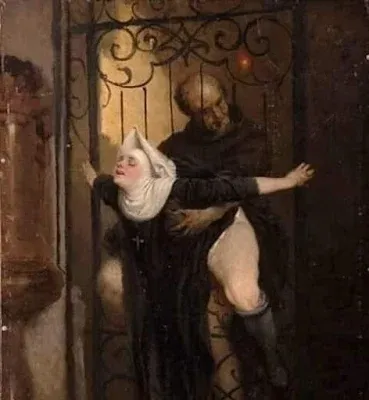The Chestnut Banquet
On the night of October 30, 1501, on the eve of All Saints' Day, Pope Alexander VI and his son Cesare Borgia organized a grand party in the Apostolic Palace Vatican.
To this party were invited several cardinals and bishops, as well as the most important authorities of Rome. As was usual in these celebrations, the banquet was luxurious and no expense was spared, serving a great variety of food and drink for the enjoyment of those present.
However, and despite the fact that the dishes
were fabulous, the best was yet to come. And it was that once the desserts were
finished, and to the surprise of the guests, Cesare Borgia ordered that the
tables be cleared and several candelabras be placed on the floor. Immediately,
about fifty courtesans (euphemism at that time for high-class prostitutes)
entered the room and began to dance sensually around them.
They undressed to the rhythm of the music, tied
the women's hands behind their backs, threw chestnuts on the floor and they had
to pick them up with their mouths to adopt lascivious poses that would awaken
their lust.
The Pope announced that there would be prizes
(luxurious shoes, expensive clothes and precious jewels) for those who were
able to fornicate with more courtesans.
Many, the next day, could not attend the ceremonies of All Saints' Day, which generated a further scandal of the Vatican.
The Chestnut Banquet
The party, known as "The Chestnut
Banquet" or "The Banquet of the Courtesans", was a further
example of the luxury and decadence that characterized the papal court of the
time. Alexander VI, whose birth name was Rodrigo de Borja, had been elected
pope in 1492 and since then had led a life full of excesses and scandals.
Cesare Borgia, for his part, was the
illegitimate son of Alexander VI and one of the most controversial figures of
the time. Known for his ambition and cruelty, he had been appointed captain
general of the Church and had carried out a series of military campaigns to
expand the power of the Borgias.
The party on October 30 was a further example
of the influence that Cesare Borgia had on the papal court. According to the
accounts of the time, the courtesans who participated in the banquet were the
most beautiful and famous of Rome, and had been carefully selected by Cesare
himself.
The show that was carried out after dinner was
a further example of the lasciviousness and libertinism that reigned in the
papal court. The courtesans, who had been stripped of their clothes and tied
their hands, were forced to pick up chestnuts from the floor with their mouths,
adopting poses that aroused the desire of those present.
The Pope, who had been watching the show with
delight, then announced that there would be prizes for those who were able to
have sexual relations with more courtesans. The orgy that followed was
described by the chroniclers of the time as something never seen in the Vatican.
The next day, many of the party attendees were
unable to attend the religious ceremonies of All Saints' Day, which generated a
great scandal in the city. The news of the Chestnut Banquet spread quickly
throughout Europe, and was a further example of the corruption and discredit in
which the Catholic Church had fallen.
Despite the scandals and criticisms, Alexander VI and Cesare Borgia continued to exercise their power in the papal court for several years more. It was not until the death of Alexander VI in 1503 and the fall from grace of Cesare Borgia shortly afterwards that the Catholic Church began to recover from the excesses and decadence of the time.





Comments
Post a Comment